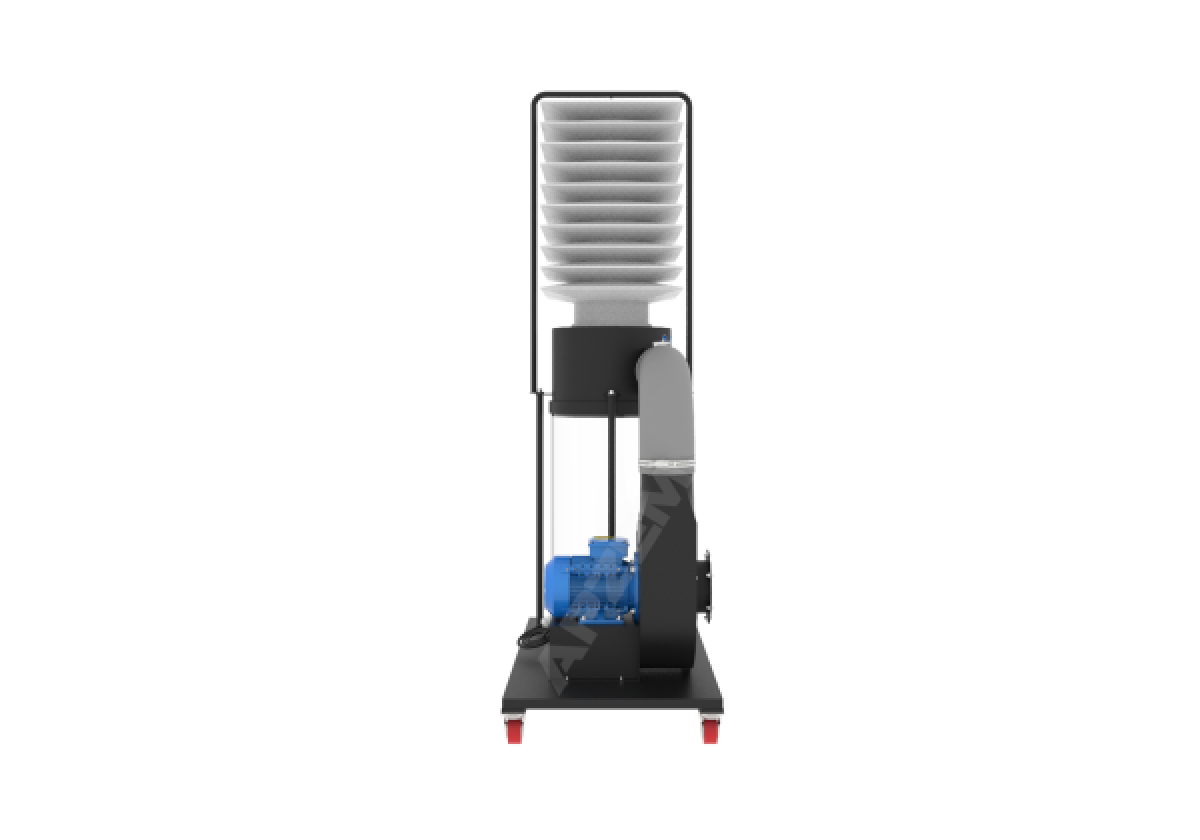Single stage dust collector (1 hp , 2hp, 3hp) Photos
Specifications:
| MODELS |
SD310 |
SD320 |
| SUCTION CAPACITY (CMH/CFM) |
680/400 |
1360/800 |
| OVERALL DIMENSIONS (L X W X H) |
900 X 520 X 1680 mm |
1050 X 580 X 1900 mm |
| MACHINE WEIGHT (APPROX.) |
75kg |
90Kg |
| WOOD PACKING SIZE (L X W X H) |
1100 X 720 X 1880 mm |
1250 X 780 X 2100 mm |
| SHIPPING WEIGHT (APPROX.) |
175kg |
200Kg |
| MOTOR POWER |
1HP |
2HP |
| MOTOR SPEED |
2880 RPM |
2880 RPM |
| POWER SUPPLY |
3 PHASE / 50Hz |
3 PHASE / 50Hz |
| RATED CURRENT |
1.6 A |
3.2 A |
| NOISE LEVEL |
<82 dB |
<82 dB |
| STATIC PRESSURE |
100mm OF WG |
100mm OF WG |
| INLET SIZE |
100mm |
Y piece (100mm dia * 2 ) |
| FILTER DETAILS |
|
|
| |
|
|
| FILTER SURFACE |
16.6 Sq. Ft |
25 Sq. Ft |
| Type of Filter |
Filter Bag |
Filter Bag |
| Filter Material |
Non Woven Needle Felt Polyester |
Non Woven Needle Felt Polyester |
| Filter Efficiency |
99% Efficiency @ 5Microns |
99% Efficiency @ 5Microns |
| Cartridge Filter |
Optional |
Optional |
Accessories:
- Spiral Ducts
- Flexible duct
- Duct clamp
- Dust collection drum (optional)
- Suction hoods
- Dampers
- Filter bags
- Filter canister
- Slide gate
- Y splitter
Warranty:
1 year from Installation date
Frequently Asked Questions
A single-stage dust collector is a type of equipment used to remove dust and debris from woodworking or industrial processes. It typically consists of a motor, a fan or impeller, a dust collection bag or canister, and a filtration system.
A single-stage dust collector works by drawing dust and debris-laden air into the unit through an intake port. The air passes through a filter, where the dust particles are captured, and then the cleaned air is expelled back into the workshop. The collected dust and debris are usually collected in a bag or canister for later disposal.
The main difference between a single-stage and a two-stage dust collector is the number of stages through which the dust-laden air passes. In a single-stage dust collector, the air is filtered once before being expelled back into the workshop. In a two-stage dust collector, the air is first separated from the larger debris using a cyclone or separator before passing through the filter, providing better dust separation and more efficient filtration.
The frequency of emptying the dust collection bag depends on how much dust is generated in your workshop. As a general guideline, you should check the bag regularly and empty it before it becomes too full, as excessive dust buildup can reduce the dust collector's efficiency.
Yes, you can connect multiple machines to a single-stage dust collector, but it's essential to ensure that the dust collector's CFM rating is sufficient to handle the combined dust output of all connected machines effectively.
While not necessary, using a dust separator or cyclone before the single-stage dust collector can significantly improve its performance. The separator will help remove larger debris and reduce the load on the filter, resulting in better dust separation and longer filter life.
The installation process may vary based on the dust collector model, so it's crucial to follow the manufacturer's instructions carefully. Generally, the dust collector should be positioned near the dust-producing machines, and appropriate ductwork should be installed to connect each machine to the dust collector's intake ports.
Single-stage dust collectors typically use filters made of cloth, paper, or other porous materials. The frequency of filter replacement depends on the amount of dust generated and the type of filter used. Refer to the manufacturer's guidelines for recommended filter replacement intervals.
The noise level of a single-stage dust collector varies depending on the model and motor power. Some dust collectors are designed with noise reduction features, but it's advisable to wear hearing protection when operating any machinery that produces noise.
Single-stage dust collectors are primarily designed for wood dust and debris. While they might be able to handle other materials to some extent, it's essential to ensure that the dust collector is rated and equipped for the specific material being collected to avoid any damage or safety issues.
Yes, some safety precautions are crucial when using a single-stage dust collector. Always wear appropriate personal protective equipment (PPE) like safety glasses, a dust mask, and hearing protection. Make sure the dust collector is properly grounded to prevent static electricity buildup, which could lead to fire hazards.
Common issues with single-stage dust collectors may include reduced suction power, clogged filters, or leakage. Refer to the user manual for troubleshooting tips, or contact the manufacturer's customer support for assistance.
Regular maintenance is crucial to ensure the longevity and efficient operation of your dust collector. This may include checking and cleaning the filters, inspecting the hoses and connections, and ensuring the motor and impeller are clean and functioning correctly.
The power consumption of a single-stage dust collector varies depending on the motor size and the specific model. It's usually measured in horsepower (HP) or amps (A), and you can find this information in the product specifications provided by the manufacturer.
Single-stage dust collectors are typically designed for indoor use in enclosed workshops. Using them outdoors might expose the equipment to environmental elements, which could lead to damage and reduced performance. Always check the manufacturer's guidelines to ensure the dust collector is suitable for your intended use.
Single stage dust collector (1 hp , 2hp, 3hp) Videos
